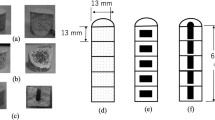Abstract
Chemical reactions carried out under microwave irradiation often have high reaction rates and high selectivities, which enable compact reactor sizes and energy-conservation processes. Thus, microwave chemical processing and chemical synthesis have attracted considerable interest, as they will be employed for greatly improving process efficiencies and conserving energy for realizing “Green Chemistry” or “Green Engineering”. We have applied this technology to smelting process of magnesium metal. But Oxide (dolomite) does not absorb microwave energy well and does not generate heat. This time, when electrically conductivity ferrosilicon used as a reducing agent was mixed with the raw dolomite material and made into an antenna structure, it became easier to absorb the microwave energy and reduce the temperature. We have successfully obtained small amount of magnesium metal using a microwave irradiation with high yield of 71%, and also showed quarter of energy consumption in comparison with conventional process, which is called Pidgeon process.
Access provided by CONRICYT-eBooks. Download conference paper PDF
Similar content being viewed by others
Keywords
Introduction
Chemical reactions performed under microwave irradiation often demonstrate high reaction rates and high selectivities, which allows for more compact reactors and more energy-efficient processes than conventional heating methods. Microwave chemical processing and chemical synthesis have therefore attracted significant attention as means of improving process efficiencies and conserving energy for realizing “green chemistry ” or “green engineering ” [1]. Currently, the smelting of magnesium metal is mainly performed using the Pidgeon method (thermal reduction method) where the material temperature is raised using a large amount of coal as the heat source. About 80% of magnesium metal is produced in China. A large amount of coal is consumed for smelting, resulting in the generation of the air pollutant PM 2.5 (fine particulate matter) and the release of carbon dioxide to the atmosphere, which are major problems. The Pidgeon method is a technique for heating dolomite ore and silicon iron to high temperatures and then cooling the evaporated magnesium to obtain magnesium metal.
* s: Solid, g: Gas
Dolomite mineral: MgO, CaO; Ferrosilicon: FeSi, Heat source: Coal.
In this study, we have investigated a new Pidgeon process, using microwaves instead of coal as the heat source, for producing Mg with lower energy inputs and a decrease in greenhouse gas emissions [2].
Experimental
Normally, dolomite is a poor absorber of microwave energy and does not generate heat. However, by using ferrosilicon as the reducing agent, devising the shape of the raw material pellet obtained by mixing dolomite and ferrosilicon and forming it as an antenna so that it has a resonance structure of 2.45 GHz (same as the frequency for microwave ovens), it was possible to confine the microwave energy to the briquettes. The small-scale experimental reactor consists of a multi-mode applicator, a stirrer fan, and a magnetron as a microwave source and experiments were conducted to confirm the antenna effects and smelting briquettes. Then, a demonstration furnace about 5 times larger than the experimental furnace was constructed and conducted to estimate the energy consumption of smelting Mg using microwave irradiation .
Results and Discussion
In a small-scale experimental reactor, 1 g of magnesium metal was smelted successfully. Figure 1 shows the result of X-ray diffraction and the photo of the obtained magnesium metal smelting magnesium. And in a large-scale experimental reactor, 7 g of magnesium metal was also obtained and the energy consumption of the new microwave Pidgeon method could be reasonably estimated as 58.6 GJ/t (Mg).
Conclusion
This success in saving energy for smelting magnesium metal has led to the possibility of this technique being developed and applied to the high temperature reduction process of oxides. In the future, through further development of this research, it will be applied to the smelting of other metal materials to save energy with steel, metals, materials, and chemistry, which have not advanced, and help reduce carbon dioxide, which is one of the causes of global warming.
References
Y. A. Çengel, “Green thermodynamics,” Int. J. Energy Res., vol. 31, pp. 1088–1104, 2007.
Y. Wada, S. Fujii, E. Suzuki, M. M. Maitani, S. Tsubaki, S. Chonan, M. Fukui, N. Inazu, “Smelting magnesium metal using a microwave Pidgeon method,” Sci. Rep. 2017, 7, 46512, https://doi.org/10.1038/srep46512.
Author information
Authors and Affiliations
Corresponding author
Editor information
Editors and Affiliations
Rights and permissions
Copyright information
© 2018 The Minerals, Metals & Materials Society
About this paper
Cite this paper
Fujii, S., Suzuki, E., Inazu, N., Tsubaki, S., Maeda, M., Wada, Y. (2018). Study on Metal Smelting Process Under Microwave Irradiation. In: Orlov, D., Joshi, V., Solanki, K., Neelameggham, N. (eds) Magnesium Technology 2018. TMS 2018. The Minerals, Metals & Materials Series. Springer, Cham. https://doi.org/10.1007/978-3-319-72332-7_26
Download citation
DOI: https://doi.org/10.1007/978-3-319-72332-7_26
Published:
Publisher Name: Springer, Cham
Print ISBN: 978-3-319-72331-0
Online ISBN: 978-3-319-72332-7
eBook Packages: Chemistry and Materials ScienceChemistry and Material Science (R0)




